Skiing in Alta Badia
Alta Badia’s ski area links Corvara, Colfosco, La Villa, Badia and San Cassiano (including Armentarola) and the lift pass also covers Lagazuoi in Cortina. Most of the local slopes are easy blue pistes, but strong skiers can use the Sellaronda lifts to visit Arabba and Val Gardena which have tougher terrain, or ski deeper into Cortina via the Grande Guerra circuit. Alta Badia’s mountain restaurants are also justly famous.
Alta Badia Ski Area Overview
Although the Alta Badia villages are linked by lifts and pistes, they each have their own sector.
Corvara
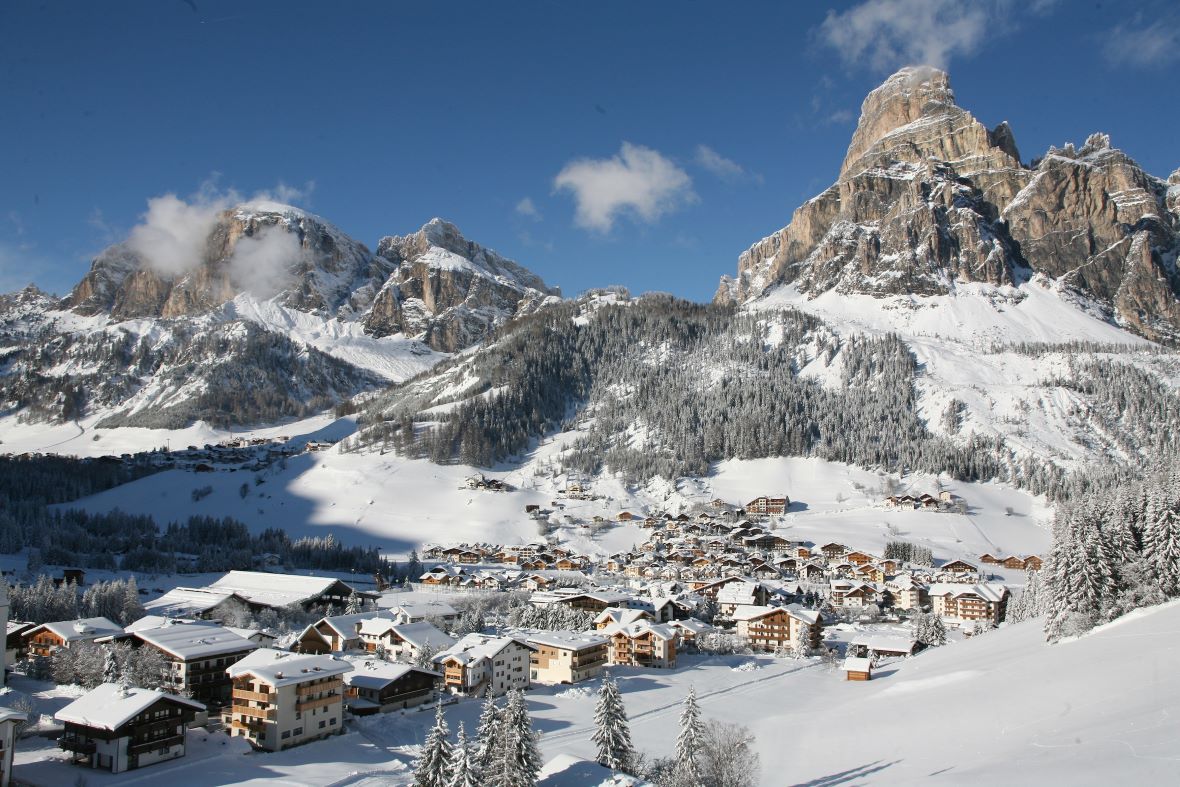
Corvara © Alta Badia _ Freddy Planinschek
Corvara, at an altitude of 1,568m, has skiing on both sides of the valley that runs between Corvara and Passo Campolongo (the gateway to the Arabba-Marmolada ski area).
The west side is on the flanks of the Gruppo del Sella. The highest lift, Vallon, reaches 2,550m making it the highest lift in Alta Badia. (Lagazuoi – see below – is higher but technically part of Cortina d’Ampezzo). There is only one route down from the top of Vallon, a narrow, twisty, but not very steep black run. At its bottom, you either turn left towards Corvara on Boé or keep straight on, eventually coming down to the valley road on either a red piste (#22a) or a blue piste (#2), from where you can cross over to the east side of the valley.
The east side of the Corvara-Campolongo valley consists of a series of gently sloping mountains about 2,000m high, connected by about 25 easy blue runs. Pralongiá is the sector highpoint at 2,157m. This is one of the best ski areas for beginners, novices and less confident intermediates in all the Alps, but stronger skiers will want to ski through it to reach the steeper slopes that descend into La Villa, San Cassiano and Armentarola.
Colfosco
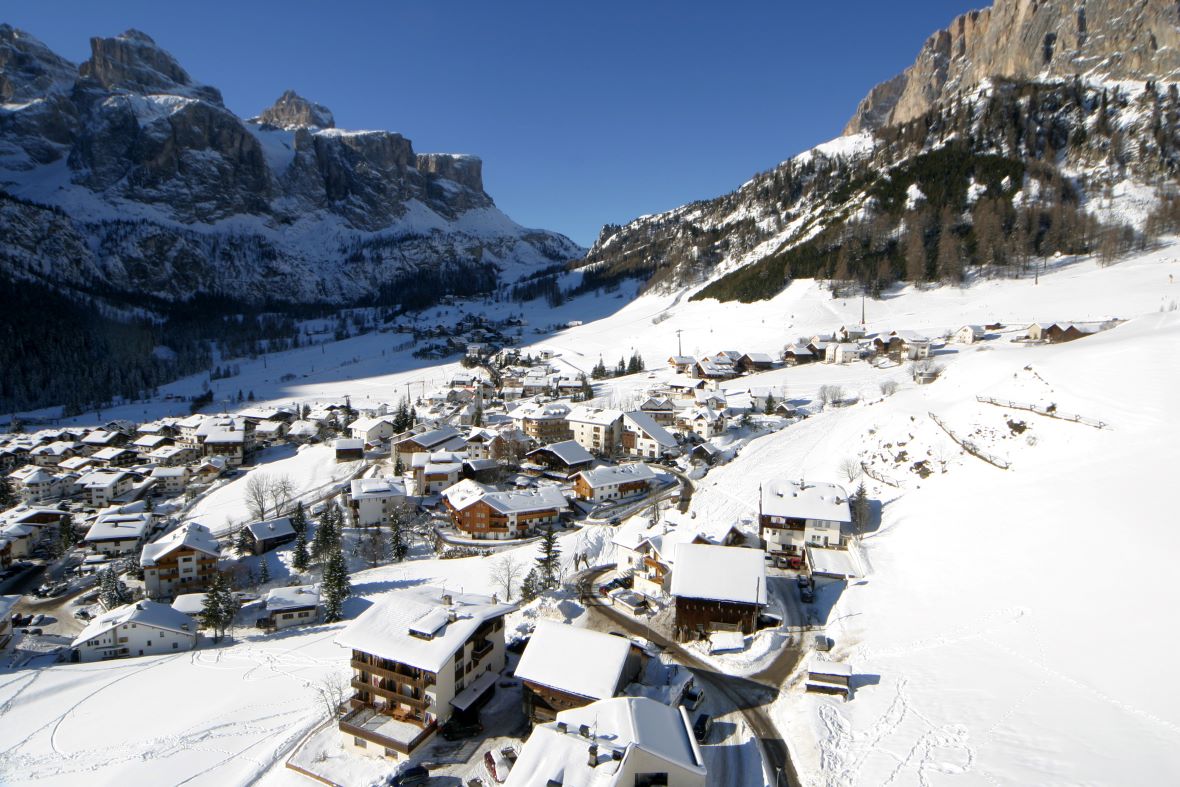
Colfosco © Alta Badia _ Freddy Planinschek
At 1,645m above sea level, Colfosco is the highest ski resort in Alta Badia and on the Sellaronda. It has two ski areas, both dominated by gentle blue runs.
Immediately to the north of Colfosco is the small crucifix-shaped Stella Alpina sector below the beautiful Sassongher mountain. You can ski this from top to bottom on easy blue runs but there are a couple of red runs and one short black run that form the arms of the cross. This sector mostly faces south so snow conditions can deteriorate in warm weather.
To the west of Colfosco, following the path of the valley road that heads towards Passo Gardena and the Val Gardena Ski Area are some long, gently-sloping east-facing ski slopes. The lowest ones, closest to the resort, accessed from the Plans gondola are graded blue and are excellent ‘first proper runs’ for novices. The higher ones, accessed from the second stage of the gondola and the lifts above it, are graded red. They are steeper at the top but soon moderate.
La Villa
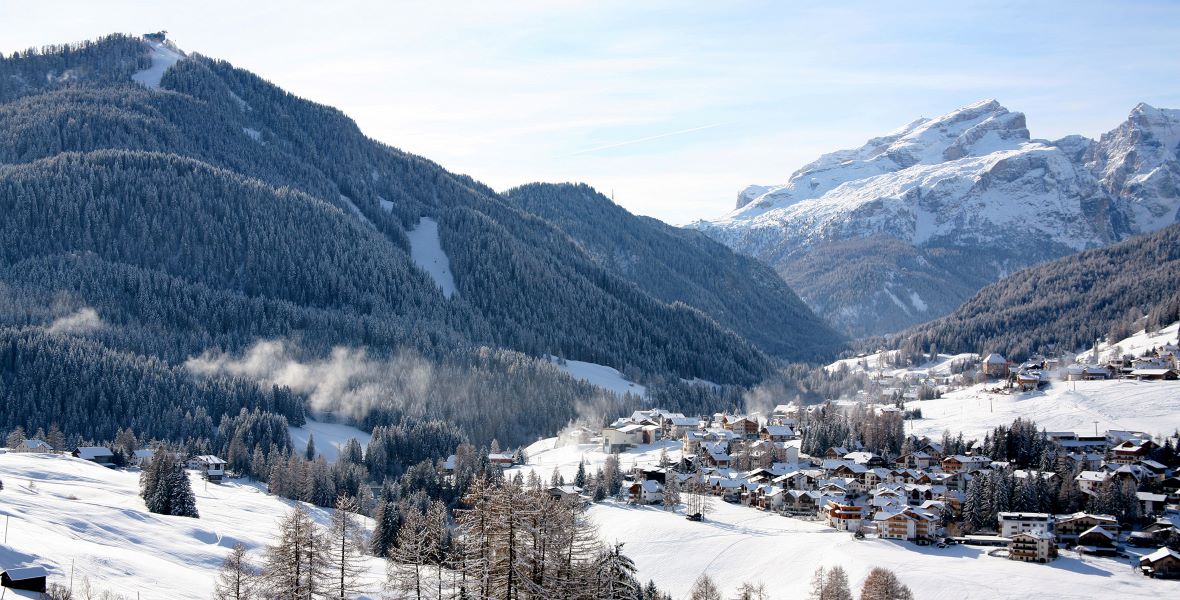
La Villa with Gran Risa black run in background. © Alta Badia_ Freddy Planinschek
La Villa, at an elevation of 1,433m, has two ski areas: Piz La Ila (2,100m) to the south of the resort and Gardenacia (1,703m) to the north-west, where the Sponata piste is.
Piz La Ila connects La Villa to Corvara, the wider Alta Badia ski area and the Sellaronda but it’s far more than just a gateway. Its north-facing Gran Risa slope is one of the steepest black runs in all the Dolomites and an official stage of the Alpine Skiing World Cup. The nearby red run (Altin) is also good.
Gardenacia leads to Badia and the journey over is a nice one because the Sponata red run is another good treelined north facing slope.
Badia
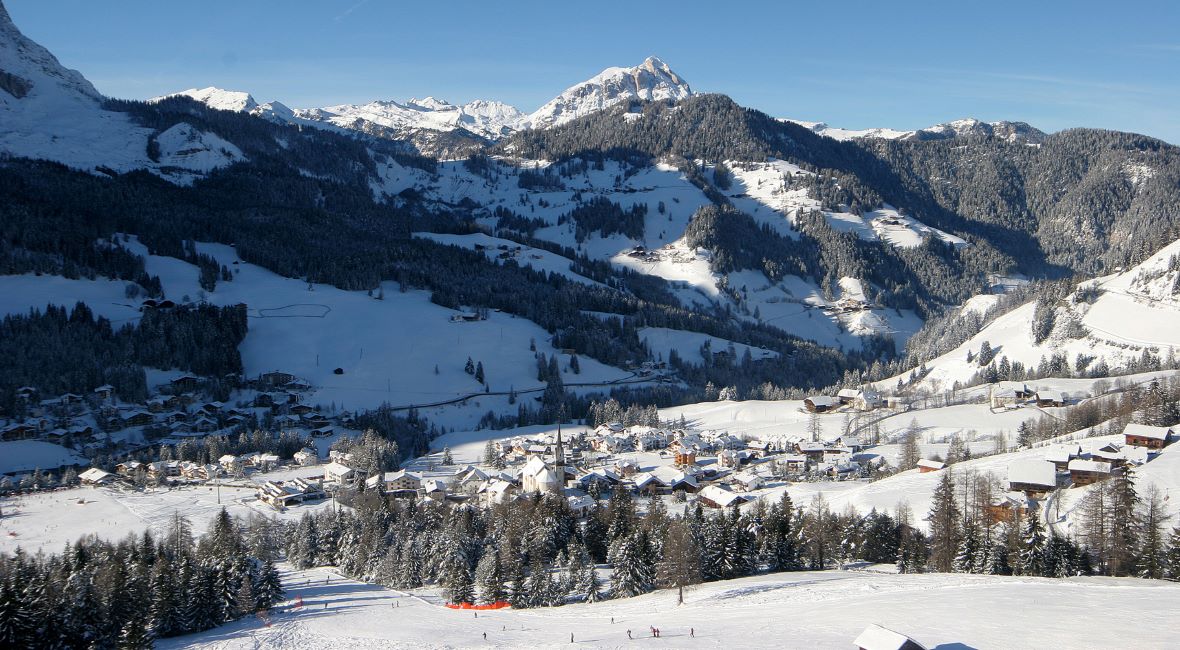
Badia Village. © Alta Badia Tourist _ Freddy Planinschek
Badia at 1324m is the lowest village and has the smallest and most isolated ski sector but it is connected to the rest of Alta Badia via the two way Pradüc chair lift which links it to Gardenacia/Sponata (see above).
Above Badia, two gondolas ascend nearly all the way up to the beautiful mountain church at La Crusc/Santa Croce – it’s a five minute walk uphill to the church itself with its amazing views. Heading down there is one continuous blue slope (officially split into different pistes) plus an optional red variant and a nursery slope at the bottom, and several excellent mountain huts (see below).
San Cassiano
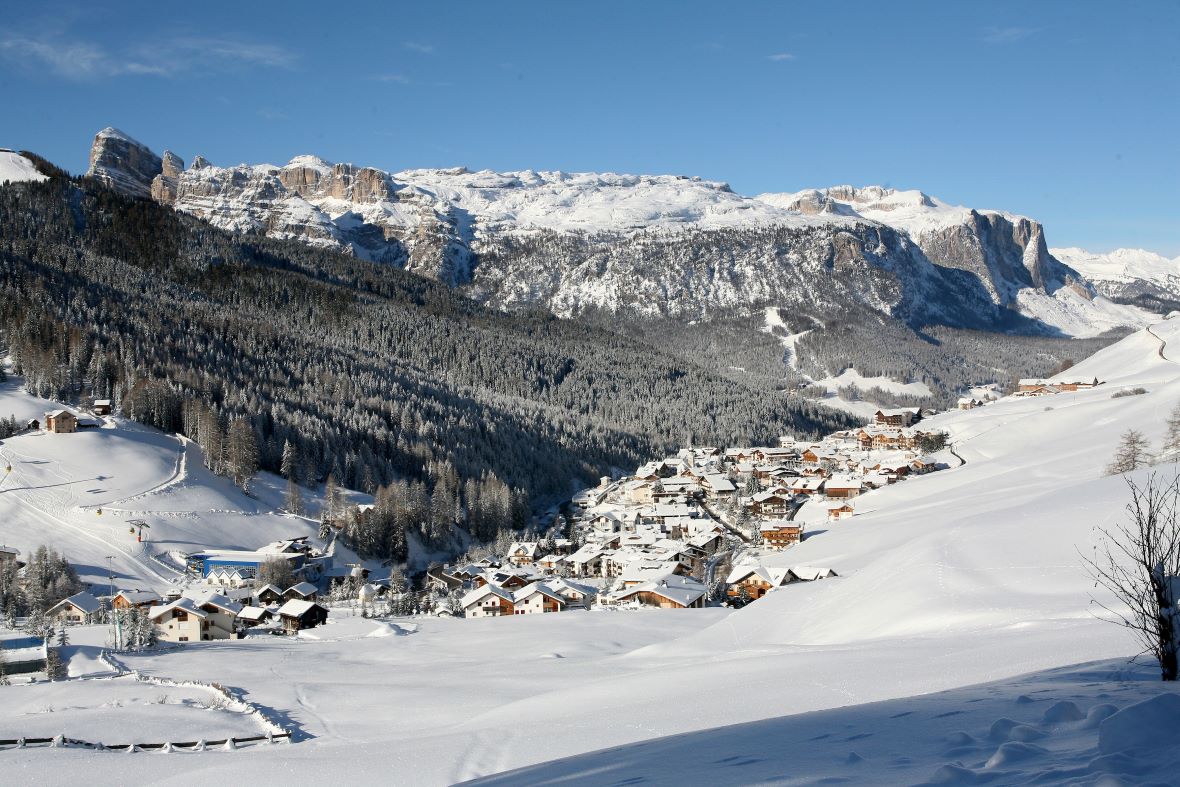
San Cassiano. © Alta Badia_ Freddy Planinschek
San Cassiano, at an altitude of 1,537m, includes the small hamlet of Armentarola at 1,621m which has its own nursery slope and one drag lift that gets you just high enough to ski to the main lift on the edge of San Cassiano. Above them are some good blue and red runs, centred on Piz Sorega (2,003m) and Bioch (2,079m). From these highpoints, you can ski back down to the San Cassiano and Armentarola or cross over to Corvara or join the Sellaronda circuits on easy blue runs.
Armentarola and Passo Falzarego/Lagazuoi
From the Hotel Armentarola car park, you can catch a taxi to Passo Falzarego, where a cable car ascends to Lagazuoi (2,778m). Technically the lift is part of Cortina d’Ampezzo, but Alta Badia ski passes cover it (although not the taxi to get there, but the price is regulated and reasonable if you fill the taxi, which is usually not a problem because there is normally a long queue of skiers waiting).
From Lagazuoi you can either ski back down to the cable car base station on a red run or ski down the 7.5km long ‘Hidden valley’ red run back to Armenatrola, which is one of the most beautiful ski slopes in the Alps. Near the end, at Capanna Alpina, the run becomes very flat so its recommended that you either call a taxi, or pay to be towed behind a horse (which is cheaper than a taxi).
If there are no taxis waiting at either Hotel Armentarola or Capanna Alpina, call +39 0471 180000 to summon one.
Alta Badia and the Sellaronda
Corvara and Colfosco are on the Sellaronda circuit, and skiers staying in Alta Badia can use the Sellaronda to ski over to Arabba, Val Gardena, and Val di Fassa. This gives them access to one of the world’s largest lift-linked ski areas (about 500kms of ski slopes, divided into about 400 separate runs, accessed by over 200 ski lifts) , all covered by the Dolomiti Superski lift pass.
You can also spend a day simply going around the Sellaronda in either a clockwise (the ‘Orange route’, because of its orange signposts) or anti-clockwise (the ‘Green route’ with green signposts) direction.
Both circuits are about 40km long (of which approximately 25km is piste) and are well within the capability of most intermediate-level skiers. There are a few mandatory red runs however, so neither circuit is suitable for beginners or very nervous skiers. The Green Anti-Clockwise route is slightly easier than the Orange clockwise route but it does have more lifts.
Most skiers complete the Sellaronda in under three and a half hours if they don’t stop. But with breaks, detours, refreshments and lift queues, it effectively takes up an entire day. Therefore you are strongly advised to start the circuit before 10am. This is not a problem if you’re staying in Colfosco or Corvara which are on the Sellaronda circuit, but takes more planning if you are staying in La Villa, San Cassiano, Armentarola or Badia.
Alta Badia and Cortina d’Ampezzo (“Grande Guerra circuit”/”First World War Ski Tour”)
Passo Falzarego is part of Cortina’s Cinque Torri ski sector. Alta Badia based skiers with a Dolomiti Superski lift pass can ski further into Cortina’s ski area. Strong skiers who get a move on, should be able to enjoy the fine red runs at Pomedes as well as the Cinque Torri blues and reds, before making the long, but highly enjoyable journey back to Alta Badia via Lagazuoi.
Cortina d’Ampezzo and Ski Civetta can also be explored via the First World War Ski Tour, or ‘Grande Guerra’ circuit. Like the Sellaronda, the First World War Ski Tour can be skied in either a clockwise direction (purple signs) or anti-clockwise (red signs). It takes a full day to complete.
For instance, the Grande Guerra purple circuit lets skiers from Alta Badia enter the Cortina d’Ampezzo ski area at Passo Falzarego, ski all the Cinque Torri slopes, then exit the Cortina d’Ampezzo ski area at Passo Giau near Fedare, from where a bus takes them to the Ski Civetta ski resort of Pescul. They then cross the Ski Civetta, exiting the ski area at Alleghe, from where another bus takes them 15km to Malga Ciapela at the foot of the Marmolada glacier in the Arabba ski area. They then use the Sella Ronda lifts to return to Alta Badia.
All the ski lifts and slopes in Cortina d’Ampezzo and Ski Civetta are covered by the Dolomiti Superski pass. The buses are extra but are relatively inexpensive. They leave approximately every 30 minutes and there are other buses not linked to the First World War ski tour. Full timetable and prices available at https://www.dolomitisuperski.com/en/Experience/Sellaronda-Grande-Guerra.
Anyone who is interested in the First World War should also visit the museums on Marmolada (at the top of the second cable car) and at Lagazuoi.
Beginner Skiing in Alta Badia
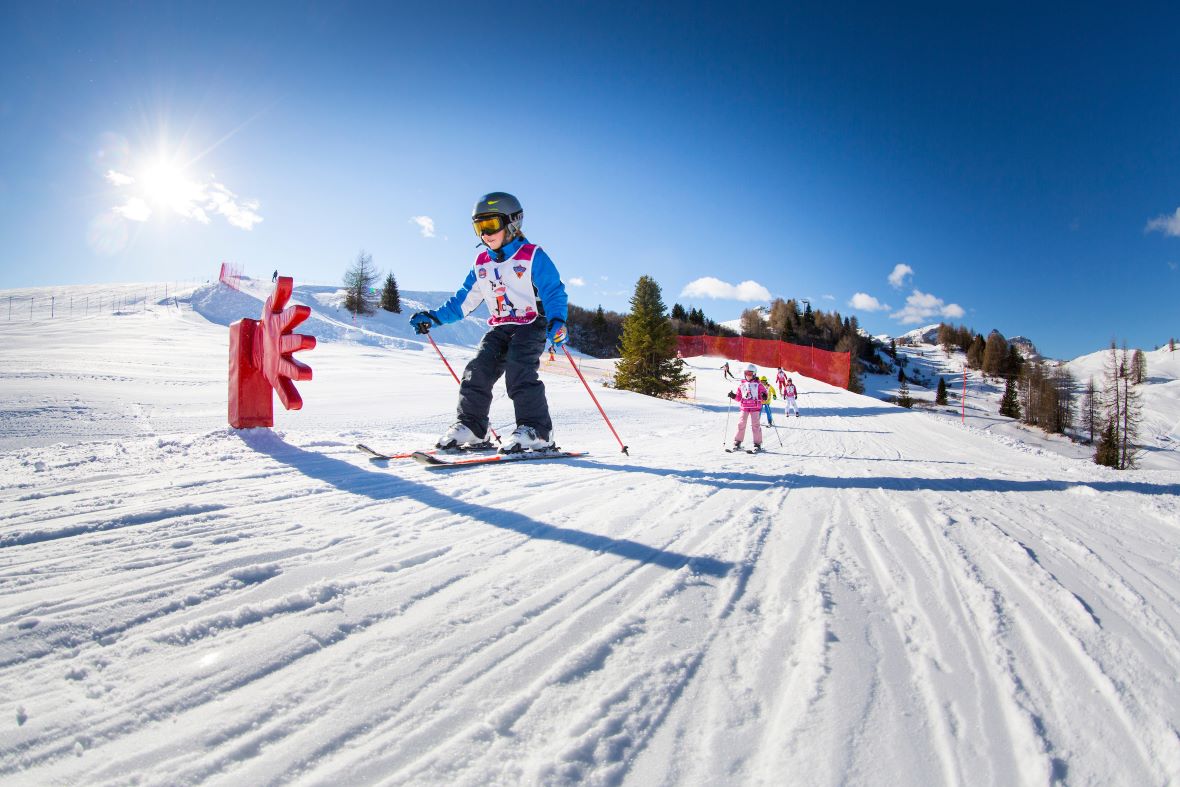
Alta Badia Ski School © Alta Badia_ Patrick Steiner – QParks
Corvara and Colfosco are two of the best ski resorts in the Alps for beginners learning to ski. There are nursery slopes close to both villages, and beginners can get from one resort to the other using the 2-way Borest lift. Once beginners are ready to leave the nursery slopes , there are lots of easy blue runs to move onto. The area heading eastwards from Corvara to San Cassiano via Piz Arlara, Bioch and Pralongiá is particularly good for novices, as is the blue run coming down to Colfosco from Passo Gardena under the Plans bubble lift.
The hamlet of Armentarola outside San Cassiano also has good nursery slopes and nearby blue runs to progress onto. The nursery slopes are quite far from most of the accommodation in the rest of San Cassiano though.
La Villa and Badia have facilities for beginners but overall Colfosco and Corvara are better locations.
Intermediate Skiing in Alta Badia
Intermediates who like easy cruising on blue runs in beautiful scenery with excellent mountain restaurants will enjoy the local Alta Badia ski area.
Those who want to be tested more have a few local highlights to enjoy (Boé, Lagazuoi, Piz Sorega, and Altin are all good red runs) but will want to buy the Dolomiti Superski liftpass so they can use the Sellaronda lifts to make day trips to the excellent red runs (and red-ish black runs) in Val Gardena, and the top to bottom red run descents of Marmolada and Porta Vescovo in Arabba.
The Dolomiti Superski pass also covers Cortina d’Ampezzo (reached via Falzerego – see above) , Kronplatz (reached by bus from Badia) and Ski Civetta (part of the Grande Guerra circuit) which all have good red runs.
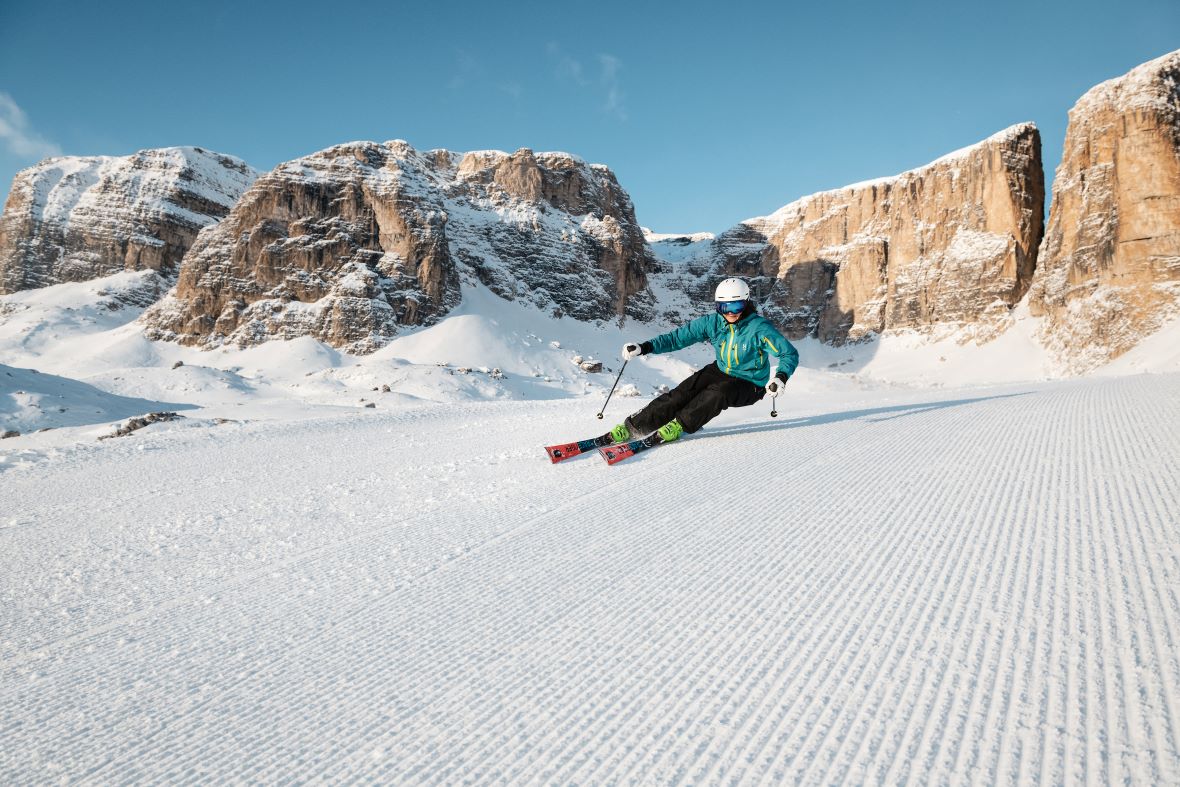
Alta Badia Ski Slopes are groomed every night © Alta Badia_IDM Suedtirol – Alex Moling
Advanced and Expert Skiing in Alta Badia
Alta Badia has one extremely good, and seriously steep, black run in the north-facing Gran Risa that runs from the summit of Piz La Ila down to La Villa.
The east-facing black run Vallon above Corvara is narrow and twisty rather than steep, but combined with the red run Boé below it, it makes a lovely long continuous descent with a vertical drop of about 1,000m.
The west-facing black run from Col Pradat in the Stella Alpina sector above Colfosco is short (about a 200m vertical drop) and sweet, and is steep enough to grab your attention from the surrounding scenery, particularly if you ski it in the morning when it could be hard and icy.
Advanced skiers based in Alta Badia however should buy the Dolomiti Superski liftpass so they can use the Sellaronda lifts to make day trips to Arabba and Val Gardena.
In Arabba, all the black runs on Porta Vescovo are worth exploring, and advanced skiers can also test their stamina on Marmolada, including a black variant that is part of the descent.
The black runs in Val Gardena like Saslong, Ciampinoi 3, Cir, La Ria, and Paprika are also very enjoyable, and all are within easy reach of skiers based in Corvara and Colfosco.
Alta Badia Off-Piste Freeriding in Alta Badia
Alta Badia is not a good resort for off-piste skiers and freeriders. However there is one famous freeride descent: the Val Mezdí. This cuts through the middle of the Gruppo del Sella massif, starting at the top of the Sass Pordoi cable car on the Val di Fassa/Arabba border and ending near Colfosco in Alta Badia. You will need to hire a mountain guide: see https://www.altabadia.org/en/summer-holidays/trekking-hiking/alpine-guides.html.
Alta Badia Mountain Restaurants (“Mountain Huts”)
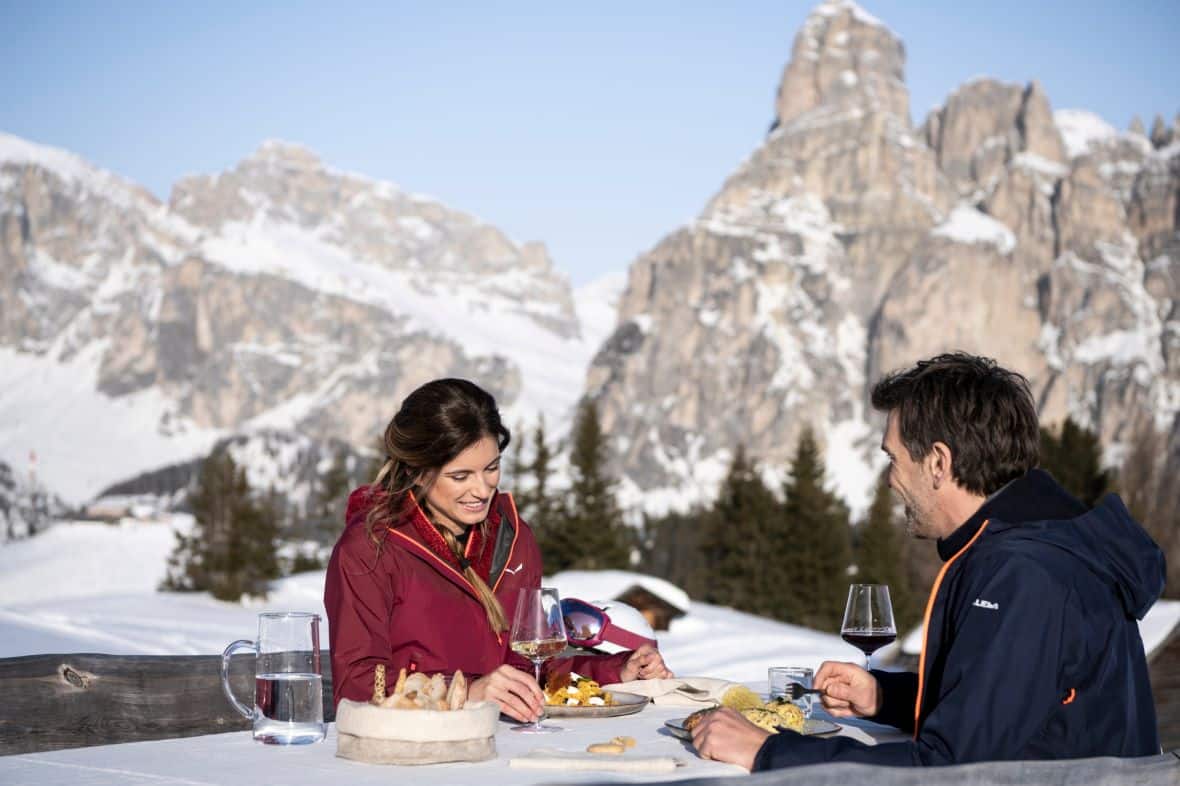
Alta Badia has some of the best mountain restaurants in the world © Alta Badia_DM Suedtirol -AlexFilz
Alta Badia is famous for its mountain huts, which typically offer a choice of Italian, Tirolean and local Ladin dishes. Almost every hut is good but particularly impressive ones include:
Edelweiss Hütte / Rifugio Edelweiss, Colfosco
In the middle of the sunny Stella Alpina sector, and easy to access from the surrounding blue, red and black runs, the hut is set in stunning scenery. There is both a table-service restaurant and a self-service café, plus terrace bar and pizzeria in case you just want a drink or a pizza. More details >>>
Sponata Hutte / Rifugio Sponata , Badia/La Villa
Near the top of Sponata, in between La Villa and Badia, this is another mountain hut in a sunny spot with great views that caters for both those wanting a proper sit-down lunch with table service and quick self-service options from a terrace counter and a café inside. More details >>>
La Crusc (Santa Croce), Badia
La Crusc above Badia is a serious ski gourmet destination with three mountain huts lining its pistes: Ütia L’Tamá, Ütia Lé (also called Rifugio Lee) and Ütia Nagler. They are all good.
I Tablá, Corvara-San Cassiano
Naming a best mountain hut in ‘blue run heaven’ between Corvara and San Cassiano is a mug’s game, because there are so many of them, and they are all good, but I Tablá consistently comes up with excellent interesting local dishes. More details >>>
Rifugio Lagazuoi, Passo Falzarego, Cortina d’Ampezzo.
This Rifugio in Cortina is easily reached by Alta Badia-based skiers skiing down from Lagazuoi but most overlook it, as they want to start the 7km descent back to Armentarola immediately. But take your time and visit the Rifugio at the top of the cable car. The views, of course, are stunning and the food surprisingly good for such an isolated spot, plus there is the Grande Guerra museum next door which includes restored trenches and gun emplacements. More details >>>










